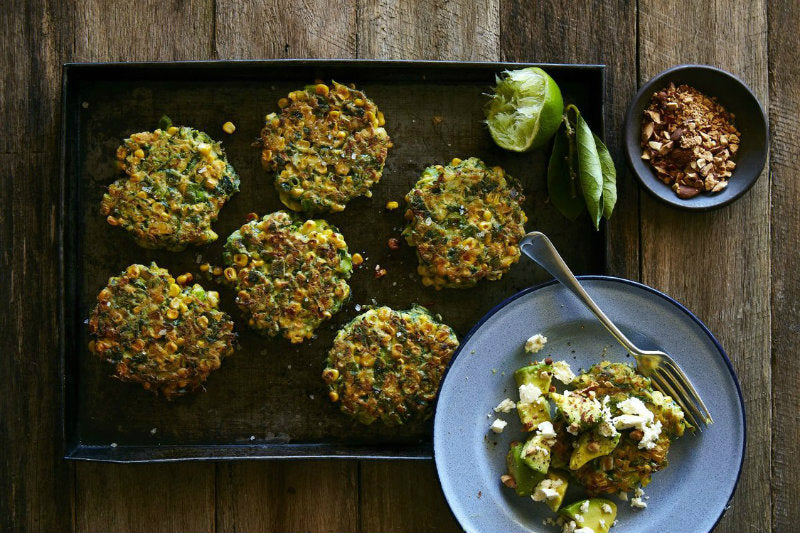When we think about food we think about our fridges and cupboards, and the supermarket at the local shopping centre. We are extremely lucky to have food so readily available to us that it is often so far removed from our line of thought to even consider the fact that the zucchini and corn on our plate has been borne from the very soil we walk on every day. For author and chef Jane Grover, every step of the food-making process is a part of her every day.
Jane Grover recently took Hoselink on a sensory adventure through her home garden on Sydney’s Northern Beaches. From street view it is difficult to see Jane’s garden nestled in the front corner of her yard. Four raised garden bed plots take up the majority of her gardening space with a large arching wire arbour decorating the space. Jane explains that Summertime is her favourite time of year because she gets to enjoy the fruits of her tomato plants; one of her favourite things to grow. It is apparent that her garden is a healthy ecosystem as she digs around in the soil to establish her tomato seedlings. The worms in the soil wriggle wildly and bees hang overhead attracted by newly blossomed nasturtium flowers. Jane became interested in gardening due to her passion for fresh produce and cooking it well. With a background in fine dining, Jane’s inquisitive nature and desire to utilise the freshest local, seasonal produce led her to cooking with ingredients direct from farmers’ markets, local produce fairs and home gardens.

‘Food is all about the seasons. I wanted to learn more about the seasons, and to garden is the best way to learn what should be served on our plates,’ explains Jane. ‘When you use seasonal produce, you know it has the highest nutritional content because it is growing in its preferred season and climate.’
Jane has been gardening for almost eight years now and says it is definitely a skill you acquire through learning. A combination of getting to know farmers and her love for whole foods inspired Jane to cook with the fruits of her labour. Jane says that gardening takes patience but is extremely rewarding when you get to take your own homegrown produce into the kitchen and start to cook with it: ‘You have to work with the seasons, and you should grow what you think you will eat. One year I planted lots of beetroot and then I realised, that’s great, but we don’t actually eat lots and lots of beetroot!’ Jane laughs.
Jane utilises every section of her front yard to its full potential. The right side of the yard is occupied by six feathery Isa Brown hens who she says are well pampered. Jane fills up their water holders and clears out their pen all the while the hens watch on from under the shade of Jane’s brilliant magnolia trees, which are just beginning to flower. Jane collects the eggs and pops them in her produce basket along with shallots and parsley she has harvested fresh from her veggie garden.
When she is not tending to her garden or chasing the chooks, you will find Jane experimenting in the kitchen developing yummy recipes for her family or home-run cooking classes. One of Jane’s easy yet magnificently yummy recipes is her sweetcorn and zucchini fritters with avocado salsa, which she is cooking for me today.

‘Cooking is not supposed to be complicated. The simpler the better. By taking a fresh tomato or lettuce, a couple of carrots and some herbs out of the garden and into the kitchen to add to your recipes, you can start to understand how rewarding and easy it is to take your produce from garden to plate.’
Jane’s garden to plate top tips:
- Garden with the seasons – your seeds won’t grow to their best potential if you are growing them in an undesirable climate. They may not even grow at all.
- The only way to learn to garden is to give it a go and make mistakes.
- Harvesting fresh produce gives you the opportunity to experiment with different recipes you may not have thought to try. The amount of fresh tomatoes in the garden, for example, is the only amount you have to cook with. Use food to its full potential and use all that you’ve grown.
- Plant things you know you’ll eat.
- When making the sweetcorn and zucchini fritters, salt your zucchini so all the moisture and excess water is removed, which will prevent your fritters from going soggy.
- When cooking, select your oil to reflect the desired final outcome of your dish. For the sweetcorn and zucchini fritters, coconut oil is used to provide a crunchy texture.
- All oils need to be temperature-controlled so that your food does not lose its nutrients, which can happen when the oil is burned.
- When using citrus fruits in the kitchen, roll the lime or lemon in the palm of your hand along a cutting board so that the warmth of your hand helps to loosen the juices. This will ultimately provide more juice from the fruit and less wastage.
- If you are starting out with growing your own produce, start small. Start with a pot and incorporate those herbs or lettuces into the kitchen to accompany what you are already cooking.
- Growing your own will make you understand the true reward of cooking from garden to plate.












